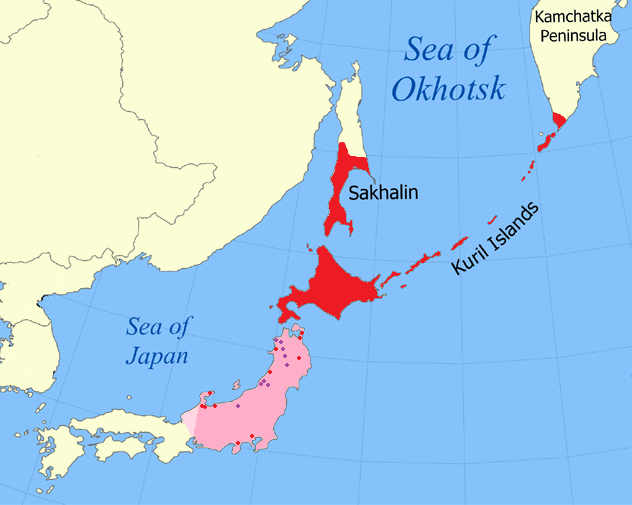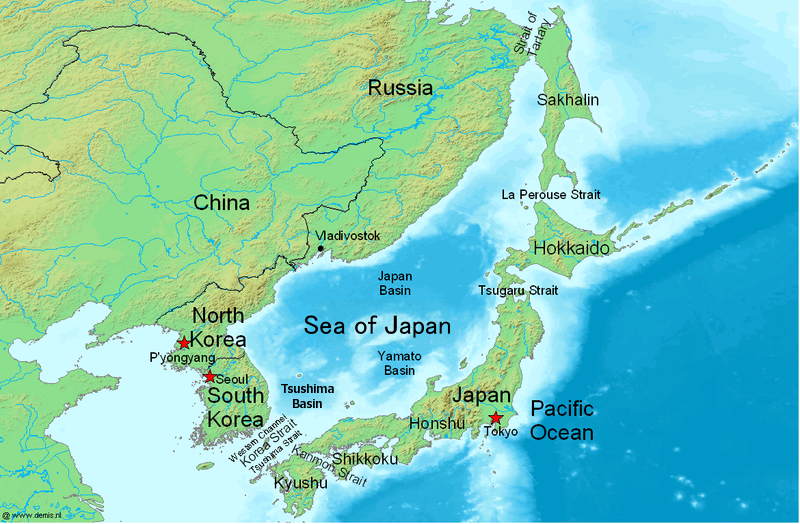|
Sakhalin
Sakhalin ( rus, Сахали́н, p=səxɐˈlʲin) is an island in Northeast Asia. Its north coast lies off the southeastern coast of Khabarovsk Krai in Russia, while its southern tip lies north of the Japanese island of Hokkaido. An island of the West Pacific, Sakhalin divides the Sea of Okhotsk to its east from the Sea of Japan to its southwest. It is administered as part of Sakhalin Oblast and is the largest island of Russia, with an area of . The island has a population of roughly 500,000, the majority of whom are Russians. The indigenous peoples of the island are the Ainu, Oroks, and Nivkhs, who are now present in very small numbers. The island's name is derived from the Manchu word ''Sahaliyan'' (), which was the name of the Qing dynasty city of Aigun. The Ainu people of Sakhalin paid tribute to the Yuan, Ming, and Qing dynasties and accepted official appointments from them. Sometimes the relationship was forced but control from dynasties in China was loose ... [...More Info...] [...Related Items...] OR: [Wikipedia] [Google] [Baidu] |
Sakhalin Koreans
Sakhalin Koreans (; ) are Russian citizens and residents of Korean descent living on Sakhalin Island, who can trace their roots to the immigrants from the Gyeongsang Province, Gyeongsang and Jeolla Province, Jeolla provinces of Korea during the late 1930s and early 1940s, the latter half of the Korea under Japanese rule, Japanese colonial era. At the time, the southern half of Sakhalin Island, then known as Karafuto Prefecture, was under the control of the Empire of Japan, whereas the northern half was part of the Soviet Union. The Japanese government both recruited and forced Korean labourers into service and shipped them to Karafuto to fill labour shortages resulting from World War II. The Red Army invaded Karafuto days before Surrender of Japan, Japan's surrender; while all but a few Japanese there repatriated successfully, almost one-third of the Koreans could not secure permission to depart either to Japan or their home towns in South Korea. For the next forty years, they ... [...More Info...] [...Related Items...] OR: [Wikipedia] [Google] [Baidu] |
Yuzhno-Sakhalinsk
Yuzhno-Sakhalinsk (, , ) is a city and the administrative center of Sakhalin Oblast, Russia. It is located on Sakhalin Island in the Russian Far East, north of Japan. Gas and oil extraction as well as processing are amongst the main industries on the island. It was called Vladimirovka () from 1882 to 1905, then during its period of Imperial Japanese control from 1905 to 1946. As of the 2010 Census, its population was 181,728. History Yuzhno-Sakhalinsk began as a small Russian settlement called Vladimirovka, founded by convicts in 1882. The Treaty of Portsmouth in 1905, which brought an end to the Russo-Japanese War of 1904–1905, awarded the southern half of the Sakhalin Island to Japan. Vladimirovka was renamed Toyohara (meaning "bountiful plain"), and was the prefect capital of the Japanese Karafuto Prefecture. During the Soviet–Japanese War within World War II, the city was recaptured by Soviet troops. Ownership of the city was transferred to the Soviet Union and it w ... [...More Info...] [...Related Items...] OR: [Wikipedia] [Google] [Baidu] |
Sakhalin Oblast
Sakhalin Oblast ( rus, Сахали́нская о́бласть, r=Sakhalinskaya oblastʹ, p=səxɐˈlʲinskəjə ˈobləsʲtʲ) is a federal subject of Russia (an oblast) comprising the island of Sakhalin and the Kuril Islands in the Russian Far East. The oblast has an area of . Its administrative center and largest city is Yuzhno-Sakhalinsk. As of the 2021 Census, the oblast has a population of 466,609. The vast majority of the oblast's residents are ethnic Russians, with a small minority of Sakhalin Koreans. Sakhalin Oblast is rich in natural gas and oil, and is Russia's second wealthiest federal subject after the Tyumen Oblast. It borders by sea Khabarovsk Krai to the west and Kamchatka Krai to the north, along with Hokkaido, Japan to the south. History The etymology of Sakhalin can be traced back to the Manchu hydronym ''Sahaliyan Ula'' (Manchu: ) for "Black River" (''i.e.'' the Amur River). Sakhalin shares this etymology with the Chinese province of Heilongjiang (C ... [...More Info...] [...Related Items...] OR: [Wikipedia] [Google] [Baidu] |
Nivkh People
The Nivkh, or Gilyak (also Nivkhs or Nivkhi, or Gilyaks; ethnonym: Нивхгу, ''Nʼivxgu'' (Amur) or Ниғвңгун, ''Nʼiɣvŋgun'' (E. Sakhalin) "the people"), are an indigenous ethnic group inhabiting the northern half of Sakhalin Island and the lower Amur River and coast on the adjacent Russian mainland. Historically, they may have inhabited parts of Manchuria. Nivkh were traditionally fishermen, hunters, and dog breeders. They were semi-nomadic, living near the coasts in the summer and wintering inland along streams and rivers to catch salmon. The land the Nivkh inhabit is characterized as taiga forest with cold snow-laden winters and mild summers with sparse tree cover. The Nivkh are believed to be the original inhabitants of the region, and to derive from a proposed Neolithic people that migrated from the Transbaikal region during the Late Pleistocene.Fitzhugh, William, and Durbreui pp.39, 40 The Nivkh had long maintained trade and cultural relations with neigh ... [...More Info...] [...Related Items...] OR: [Wikipedia] [Google] [Baidu] |
Ainu In Russia
The Ainu in Russia are an Small-numbered indigenous peoples of Russia, Indigenous people of Siberia located in Sakhalin Oblast, Khabarovsk Krai and Kamchatka Krai. The Russian Ainu people (''Aine''; ), also called ''Kurile'' (курилы, ''kurily''), ''Kamchatka's Kurile'' (камчатские курилы, ''kamchatskiye kurily'' / камчадальские айны, ''kamchadalskiye ayny'') or ''Eine'' (эйны, ''eyny''), can be subdivided into six groups. Although only around 100 people currently identify themselves as Ainu in Russia (according to the census of 2010), it is believed that at least 1,000 people are of significant Ainu ancestry. The low numbers identifying as Ainu are a result of the refusal by the government of the Russian Federation to recognise the Ainu as a "living" ethnic group. Most of the people who identify themselves as Ainu live in Kamchatka Krai, although the largest number of people who are of Ainu ancestry (without acknowledging it) are f ... [...More Info...] [...Related Items...] OR: [Wikipedia] [Google] [Baidu] |
Kuril Islands
The Kuril Islands or Kurile Islands are a volcanic archipelago administered as part of Sakhalin Oblast in the Russian Far East. The islands stretch approximately northeast from Hokkaido in Japan to Kamchatka Peninsula in Russia, separating the Sea of Okhotsk from the north Pacific Ocean. There are 56 islands and many minor islets. The Kuril Islands consist of the Greater Kuril Chain and, at the southwest end, the parallel Lesser Kuril Chain. The group termed the 'South Kurils' consists of those of the Lesser Kuril Chain together with Kunashir and Iturup in the Greater Kuril Chain. The Vries Strait between Iturup and Urup forms the Miyabe Line dividing the North and South Kurils. The Kuril Islands cover an area of around , with a population of roughly 20,000. The islands have been under Russian administration since their Invasion of the Kuril Islands, 1945 invasion by the Soviet Union near the end of World War II. Japan claims the four southernmost islands, including two of the ... [...More Info...] [...Related Items...] OR: [Wikipedia] [Google] [Baidu] |
Oroks
Oroks (''Ороки'' in Russian; self-designation: ''Ulta, Ulcha''), sometimes called Uilta, are a people in the Sakhalin Oblast (mainly the eastern part of the island) in Russia. The Orok language belongs to the Southern group of the Tungusic language family. According to the 2002 Russian census, there were 346 Oroks living in Northern Sakhalin by the Okhotsk Sea and Southern Sakhalin in the district by the city of Poronaysk. According to the 2010 census there were 295 Oroks in Russia. Etymology The name Orok is believed to derive from the exonym ''Oro'' given by a Tungusic group meaning "a domestic reindeer". The Orok self-designation endonym is ''Ul'ta'', probably from the root ''Ula'' (meaning "domestic reindeer" in Orok). Another self-designation is ''Nani''. Occasionally, the Oroks, as well as the Orochs and Udege, are erroneously called Orochons. The Uilta Association in Japan claims that the term Orok has a derogatory connotation. Population and settlement The ... [...More Info...] [...Related Items...] OR: [Wikipedia] [Google] [Baidu] |
Sea Of Okhotsk
The Sea of Okhotsk; Historically also known as , or as ; ) is a marginal sea of the western Pacific Ocean. It is located between Russia's Kamchatka Peninsula on the east, the Kuril Islands on the southeast, Japan's island of Hokkaido on the south, the island of Sakhalin along the west, and a stretch of eastern Siberian coast along the west and north. Its northeast corner is the Shelikhov Gulf. The sea is named for the port of Okhotsk, itself named for the Okhota River. Geography The Sea of Okhotsk covers an area of , with a mean depth of and a maximum depth of . It is connected to the Sea of Japan on either side of Sakhalin: on the west through the Sakhalin Gulf and the Gulf of Tartary; on the south through the La Pérouse Strait. In winter, navigation on the Sea of Okhotsk is impeded by ice floes. Ice floes form due to the large amount of freshwater from the Amur River, lowering the salinity of upper levels, often raising the freezing point of the sea surface. The ... [...More Info...] [...Related Items...] OR: [Wikipedia] [Google] [Baidu] |
Sea Of Japan
The Sea of Japan is the marginal sea between the Japanese archipelago, Sakhalin, the Korean Peninsula, and the mainland of the Russian Far East. The Japanese archipelago separates the sea from the Pacific Ocean. Like the Mediterranean Sea, it has almost no tides due to its nearly complete enclosure from the Pacific Ocean. This isolation also affects faunal diversity and salinity, both of which are lower than in the open ocean. The sea has no large islands, bays or capes. Its water balance is mostly determined by the inflow and outflow through the straits connecting it to the neighboring seas and the Pacific Ocean. Few rivers discharge into the sea and their total contribution to the water exchange is within 1%. The seawater has an elevated concentration of Oxygen saturation, dissolved oxygen that results in high biological productivity. Therefore, fishing is the dominant economic activity in the region. The intensity of shipments across the sea has been moderate owing to politi ... [...More Info...] [...Related Items...] OR: [Wikipedia] [Google] [Baidu] |
Hokkaido
is the list of islands of Japan by area, second-largest island of Japan and comprises the largest and northernmost prefectures of Japan, prefecture, making up its own list of regions of Japan, region. The Tsugaru Strait separates Hokkaidō from Honshu; the two islands are connected by railway via the Seikan Tunnel. The largest city on Hokkaido is its capital, Sapporo, which is also its only cities designated by government ordinance of Japan, ordinance-designated city. Sakhalin lies about to the north of Hokkaidō, and to the east and northeast are the Kuril Islands, which are administered by Russia, though the four most southerly are Kuril Islands dispute, claimed by Japan. The position of the island on the northern end of the archipelago results in a colder climate, with the island seeing significant snowfall each winter. Despite the harsher climate, it serves as an agricultural breadbasket for many crops. Hokkaido was formerly known as ''Ezo'', ''Yezo'', ''Yeso'', or ''Yes ... [...More Info...] [...Related Items...] OR: [Wikipedia] [Google] [Baidu] |







